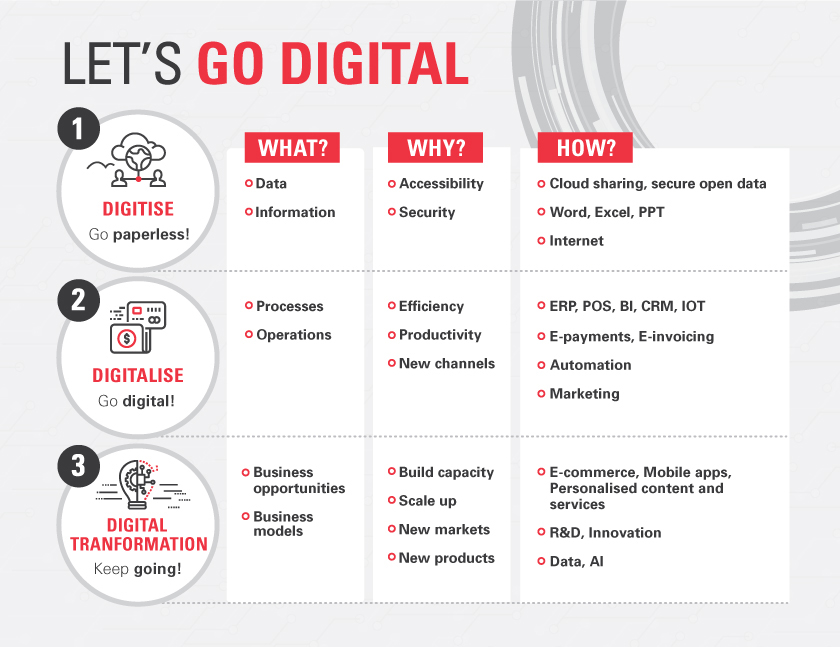This piece is adapted from an op-ed first published in The Business Times on 29 March 2019.
In working with small and medium enterprises (SMEs), micro enterprises and startups, I have had the privilege of meeting many enterprising minds. These are business leaders with great determination and passion; they are not afraid to make tough decisions. Yet when it comes to digitalisation, some find that it is a huge commitment. And understandably so, as time and resources invested do not always reap immediate returns. While most, if not all, are well aware of the long-term merits of digitalisation, much of the inertia naturally lies in taking the very first step.
Start small, but be clear on the objective
So let us start small. The first step is to set a clear objective. It could be improving the customer journey, levelling up the work experience to retain employees, or to make better use of data. If the goal is to streamline back-end processes, then it would make sense to start by digitising. This means creating virtual copies of physical documents so mail becomes email, forms become e-forms, and so forth. File sharing technology, such as cloud systems, keeps documents safe and organised. Repetitive administrative tasks are reduced. This leaves time for higher-value functions that require human touch, intelligence and creativity, from planning the next marketing campaign, to managing vendor relationships.

Digitisation is a pivotal step that will pave the way for more sophisticated business processes – inventory management, customer-relationship management (CRM) and point-of-sales (POS) – which unlock higher productivity for companies. Starting off on the right foot is important. Through the Start Digital initiative, recently launched by Enterprise Singapore and the Infocomm Media Development Authority (IMDA), young companies now have a head start in going digital from day one. Our partners comprising local banks and telcos are supporting SMEs to equip themselves with foundational digital solutions such as e-invoicing and data protection.
From digitisation to digitalisation, pave the way for scaling up
Change is happening across all sectors, from retail and food services, to manufacturing and logistics – and even in our neighbourhood minimarts. This year, Kim Eng Mini Supermarket, a well-loved traditional provision shop along Yishun Ring Road, will be marching into its ninth year of digitalisation.
Back in 2010, with support from Enterprise Singapore (then SPRING Singapore) and the Federation of Merchants’ Association Singapore, second generation owner of Kim Eng Mini Supermarket, Mr Kelvin Tan, implemented a POS and inventory management system. With this software, a purchase order that used to take 30 minutes to process could now be done in 10. It was a simple yet strategic step that allowed Mr Tan to accurately track orders, perform sales forecasts and make data-driven business decisions.

Despite initial resistance to the introduction of digital solutions, even his older employees are now confidently using these systems to improve their daily workflows and processes. Restocking of in-demand products is now conducted in a timely fashion without risk of overstocking or understocking. With an automated inventory management, Mr Tan’s employees can focus on delivering quality customer service and other front-line responsibilities, which include goods receiving and product merchandising.
The journey of digitalisation may not always be easy, but it need not be a lonely one. From Trade Associations and Chambers (TACs), Centres of Innovation (COIs) to SME centres, companies can leverage their collective strengths, resources and experiences to solve common business challenges.
For instance, local SMEs have banded together to embark on group-based (GBU) upgrading projects led by TACs and SME Centres, to transform their businesses through innovation and building capabilities. From devising a 3D body scanner for tailors to revamping clinic management systems together, more than 350 SMEs have participated in over 20 GBU projects since last year.
Digital transformation, an ongoing journey that brings new opportunities
Digitalisation is an ongoing journey of discovery, experimentation and learning. Last year, Mr Tan continued Kim Eng’s digitalisation journey by adopting a digital signage management solution called Intelli-signage to expand his marketing efforts.
In the past, Mr Tan’s employees would have had to first design the poster, send it for printing, then laminate it before finally sticking it on the wall. With Intelli-signage, he can update product information on the go. When customers read the advertisements on the interactive screen, Intelli-signage’s built-in facial recognition can estimate the age group and gender of his customers. With this data, Mr Tan is able to better understand his customers’ preferences and target his advertisements with relevant product information.

It is very encouraging that a minimart could continue with this journey for almost a decade. I believe many others can too. Intelli-signage is one of more than 30 tested and proven solutions hosted on Tech Depot, where solutions are pre-approved and supported via the Productivity Solutions Grant (PSG). The goal is to ensure digital solutions are accessible to all local businesses, small and big.
Beyond streamlining business operations, digitalisation can also open up new opportunities and markets for companies. Singapore is working closely with our neighbours to strengthen digital connectivity through the ASEAN Economic Community. This will create new opportunities for SMEs to forge meaningful cross-border business connections.
Look at how three seafood associations – the Punggol Fish Merchants Association, Seafood Industries Association Singapore and Singapore Fish Merchants’ General Association – are working with tech company vCargo Cloud on the first seafood B2B e-marketplace in Singapore. Once ready, the new digital marketplace will allow Singapore seafood merchants to trade with international customers and achieve economies of scale through pooling resources to expand into China and Europe together.
Some companies may see digitalisation as an unfamiliar and possibly expensive exercise, one where the returns are not clear. It is with this in mind that the government and industry partners have put in place ample resources to support companies at different levels of digital maturity. That said, I believe the heart of this digitalisation journey lies in the people. Problem solving is second nature to businessmen. These digital solutions are tools that will help them achieve their long-term goals and meet their day-to-day needs. I have full faith that with the right tools, right mindset and right approach, local businesses can define their own transformation journey to shine through the digital age.

